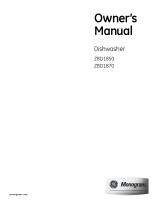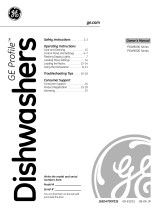11
The dishwasher will flush away all normal food soils. However, objects (fruit pits, bones, etc.) may collect in
openings and should be removed occasionally to avoid clogging the drain system.
CAUTION
Personal injury hazard. Before cleaning the interior, wait at least 20 minutes after a cycle for the heating element
to cool down. Failure to do so could result in burn injuries.
Cleaning the Spray Arms
Because hard water chemicals will clog the
spray arm jets and bearings, it is necessary
to clean the spray arms regularly. To remove
the spray arm, twist the retaining nut 90
degrees and pull the spray arm off the shaft.
Wash the arms in soapy, warm water and use
a soft brush to clean the jets. Replace them
after rinsing thoroughly.
Cleaning the Filters
For best performance and results, the filter
assembly must be cleaned regularly. The
filter efficiently removes food particles from
the wash water, allowing water to be
recirculated during the cycle. For this reason,
it is a good idea to remove the large food
particles trapped in the filter frequently by
rinsing the main filter and cup under
running water. To remove the filter assembly,
pull up on the cup handle. The entire filter
assembly should be cleaned at least once a
month. To clean the main filter and fine
filter, use a cleaning brush. Then, reassemble
the filter parts as shown in the illustration
and reinsert the entire assembly in the
dishwasher, positioning it in place and
pressing downward. The dishwasher must
never be used without the filters. Improper
replacement of the filter may reduce the
performance level of the appliance and may
damage dishes and utensils.
Cleaning the Spray Arms and the Filters
Main filter
Fine filter
Retaining
nut
Washer
Cup
Protect Against Freezing
If your dishwasher is left in an unheated
place during the winter, ask a service
technician to:
Cut off electrical power to the dishwasher.
Remove fuses or trip circuit breaker.
Turn off the water supply and
disconnect the water inlet line from
the water valve.
Drain water from the water inlet line
and water valve. (Use a pan to catch
the water.)
Reconnect the water inlet line to the
water valve.
4
3
2
1
Check the air gap any time your
dishwasher isn’t draining well.
Does Your Dishwasher Have
an Air Gap?
An air gap protects your dishwasher
against water backing up into it if a drain
clogs. The air gap is not a part of the
dishwasher. It is not covered by your
warranty. Not all plumbing codes require
air gaps, so you may not have one.
The air gap is easy to clean.
Turn off the dishwasher and lift off
the chrome cover.
Remove the plastic cap and clean with
a toothpick.
2
1
Two types of
air gaps
Retaining nut
Stainless Steel Interior—
Tub and Inner Door
The stainless steel used to make the
dishwasher tub and inner door provides the
highest reliability available in a GE dishwasher.
If the dishwasher tub or inner door should
be scratched or dented during normal use,
they will not rust or corrode. These surface
blemishes will not affect their function
or durability.
Upper rack
Consumer SupportTroubleshooting TipsOperating InstructionsSafety Instructions
Caring for the dishwasher. ge.com


















